The Best New York Style Pizza Dough and 14 Tips for Success!!
I’ve been making a lot of this NY style pizza dough recipe …. The obsession started a while back, and I’ve finally found a recipe that I love the best! After years of experiments (and I mean years!), I am now using this recipe based on recommendations from the many fine pizza makers at www.pizzamaking.com and the late great Dough Doctor, Tom Lehmann.

Making Pizza Dough at Home
Making NY style pizza dough is definitely somewhat of an art form. There are so many variables that can be changed aside from the ingredients alone. For example, these variables include:
- oven temperature
- temperature of the water used to make the dough
- proofing methods (room temp vs cold rise)
- order of adding the ingredients (yes, this makes a big difference!)
- mixing time
- use of autolyse
- use of poolish (I don’t do this or the one before, although I have in the past)
And then of course, the toppings which can be simple or as complex as you’d like. But don’t worry too much about all of this – my method is easy and straightforward. Plus, you will make better dough than 99% of the pizza chains out there. You will not want take out anymore!
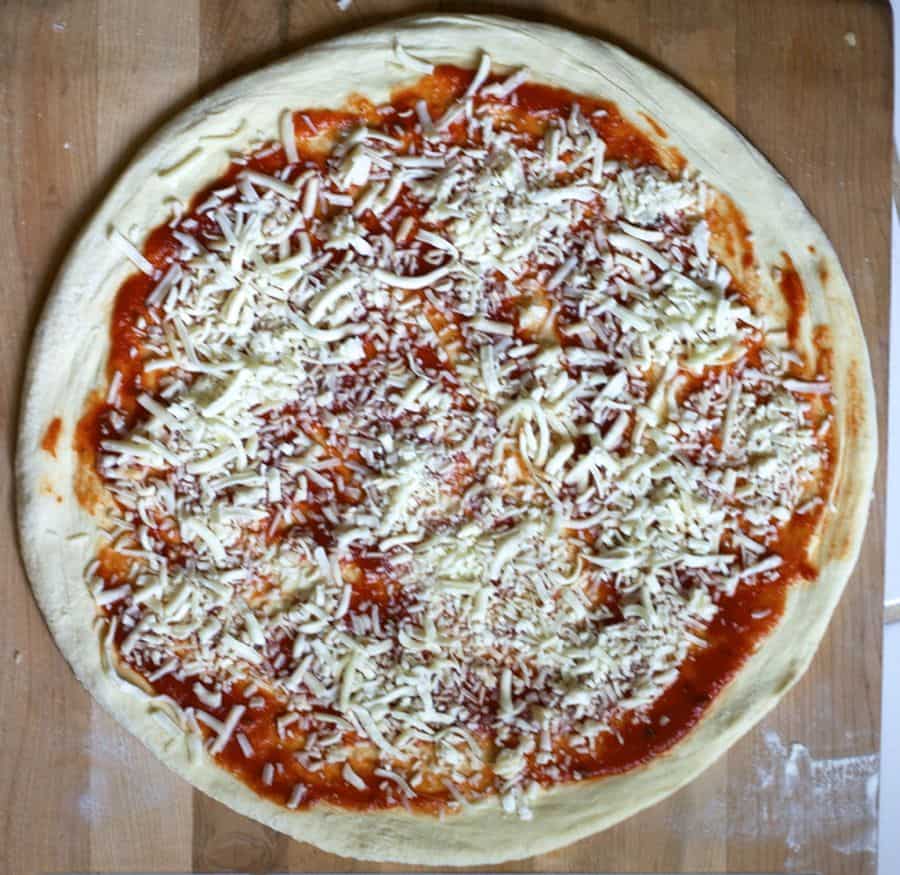
My Favorite Pizza Dough: The Big Secret (How You Proof the Dough)
My all-time favorite dough is NY style dough, which really is classic pizza dough that is stretched out into a thin crust pizza. This type of pizza dough contains water, flour, salt, instant yeast, and olive oil (and sugar especially when baking in a home oven, to help browning).
After it is mixed, it is proofed (left to rise/ferment) in the refrigerator for a minimum of 24 hours and up to 72 hours (it can also be frozen) – this is the big secret. I’ve used the dough up to 5 or 6 days afterwards, so you can essentially prepare dough for the week.
This recipe produces a crisp yet foldable crust that is tender, light, and flavorful and will make enough for four 14-inch pizzas. You can easily double or half the recipe to make 2 or 8 pizzas.

Fourteen Tips for Success
Tip 1: Choosing the flour
Use high-quality flour – I like to use King Arthur’s all purpose or bread flour; higher protein (ie, bread) flours work best. However, I prefer all-purpose flour because I like a lighter, airy crust.
Tip 2: Adding the yeast
Do not add instant dry yeast (IDY) directly to cold or cool water – you may shock the yeast (add the IDY to your flour instead) (please note that IDY differs from active dry yeast, which must be activated by adding it to water).
Tip 3: How much yeast?
Use only enough yeast to “get the job done” – yeast eats the sugar in your flour to produce its leavening effects – I find that if you use too much, your dough will be tasteless (this is just my opinion); however, it is a fact, that too much yeast can make your dough taste bad. Most recipes out there, some of them in well known, published books contain too much yeast!
Tip 4: Cold ferment that pizza dough!
Always use your refrigerator. The best NY style doughs “ferment” or “cure” in the refrigerator for at least 24 hours and up to 48 72 hours. This is called a “cold rise” (vs warm rise on your kitchen counter).
The refrigerator is used to retard (or slow) the dough’s fermentation, allowing that distinctive flavor to come through (ever wonder why some pizza crust tastes different than others, despite the fact that they are both made from just about the same exact ingredients? – this is a big reason why!)
When your dough rises too quickly, the flavor will not develop optimally. Slow rise = MUCH better flavor.
Tip 5: Weigh those ingredients!
Use a scale to weigh the flour instead of using a measuring cup – it is much more accurate and will yield superior results. I’ll admit, I resisted doing this for a loooong time. Just do it. You’ll be glad you did and your dough will be more consistent and much improved.
Tip 6: Add oil last
Mix the oil in as the last step, after the flour has all been incorporated. This is important to allow the flour to hydrate properly.
Tip 7: Flour your dough balls
Before tossing or opening your dough balls, flour them *very* well on each side (if you are a beginner) to ensure they do not stick to your counter or pizza peel. I sometimes use a bit more flour after I begin spreading them.
Tip 8: Keeping those rims a bit puffy
Take care not to “degas” the rim of your pizza as you are spreading your dough! Do NOT ever use a rolling pin! There are many different methods to spread/open your dough ball. I hope to add a few pictures someday of this process.
Tip 9: Baking pizza in a home oven
Ensure that your oven is preheated for a sufficient amount of time (about 1 hour) and bake the pizza within 6 to 8 inches of the top of your oven (ie, your broiler) so that the tops browns sufficiently in conjunction with the bottom of the pizza.
Do not place the stone near the bottom of your oven. I made this mistake for too many years.
After your stone has been preheated sufficiently, the heat from the stone will cook the pizza from the bottom and you can switch the broiler on if you find you need more browning on the top (I now use the broiler to bake my pizzas…more on this sometime in the future).
If you find that your cheese is browning well before your rim attains sufficient color, use partially frozen cheese (ie, place shredded cheese in the freezer while the oven is heating up) and cold sauce or you can drizzle just a bit of olive oil on top of cheese.
Tip 10: Use a pizza stone or steel
Use a pizza stone if you have one. The stone with draw moisture out of the dough and produce a beautifully crisp crust. I use a pizza steel because my stones kept breaking.
Tip 11: Use just the right amount of sauce
Do not use too much pizza sauce – it will make your pizza soggy
Tip 12: Find the right kind of cheese
Do not use low fat cheese to top your pizza or pre-shredded cheese (the former will not melt sufficiently and the latter contains additives that prevent the cheese from sticking together and therefore does not melt very well). The best is low-moisture, whole milk mozzarella.
If you must use pre-shredded cheese, I’ve found that adding the sauce on top of the cheese helps with the melting. Also, do not use too much cheese; apply it sparingly so that you can achieve that mottled NY pizza appearance.
Tip 13: Flour your pizza peel
Use semolina or flour on the bottom of your pizza peel to prevent the pizza dough from sticking but be careful not to overdo it because it will burn.
Tip 14: Learn to launch that pizza
Give the pizza peel a few very small quick jerks to make sure the pizza will easily slide off your pizza peel before attempting to transfer pizza to the oven, and more importantly, rub flour into the peel before placing the dough on top.
Essential Equipment
Please note that as an Amazon affiliate, we earn a small commission if you purchase a product at no additional cost to you.
I adore my baking steel; it’s transformed my home pizzas into restaurant-quality and better. You will love this! A kitchen scale streamlines measurement with remarkable accuracy, while a pizza peel is essential for smoothly sliding pizzas into the oven. And proofing boxes provide an optimal storage for pizza dough fermentation, enhancing flavor, texture, and elasticity.
Please visit our SHOP page for more recommended tools and equipment to make restaurant-style NY-style pizza at home!
How to Stretch the Pizza Dough
A nice video (from The GoodFellas Pizza School of NY), showing how to stretch the dough:

How to Freeze Homemade Pizza Dough
- After mixing dough and dividing into balls, place dough in refrigerator for at least 24 hours.
- Place dough balls on baking sheet lined with plastic wrap or parchment paper, cover loosely with plastic wrap and freeze until firm (~ 2 to 3 hours or up to overnight).
- Wrap frozen dough balls individually in plastic and store in zipper-lock bags for up to 4 weeks.
- When ready to bake, transfer unwrapped dough into the refrigerator for 12 to 24 hours before making pizza.
- Bring dough to room temperature for 20 to 60 minutes before baking (less time for hot kitchen/summer and more time for cool kitchen)
Pizza Dough Calculator
Need more dough? Less dough? Try out our new Pizza Dough Calculator to calculate the weights to get it just right!
Have More Questions?
Please See My NY Pizza FAQ
If you tried this recipe, please leave a 🌟 star rating and let me know how it went in the 📝 comments below! SUBSCRIBE for more recipes.
📖 Recipe

The Best New York Style Pizza Dough
Equipment
- pizza stone or pizza steel for baking
- Standing mixer optional or hand knead
- kitchen scale highly recommended instead of volume measures
Ingredients
Original Recipe for Four 14-Inch Pizzas; want to make more or less? Use the pizza dough calculator
- 6.5 cups (796 g) all purpose flour or bread flour (weighing is most accurate!)
- 2 1/4 cups (493 g) water barely cold water (17.4 oz per 2 1/4 cups)
- 1 teaspoon (3.5 g) instant dry yeast
- 2.5 teaspoons (15.6 g) salt
- 2 teaspoons (7.8 g) sugar
- 1 tablespoon (11.8 g) olive oil
1 Pound of Dough (~454 grams) (use the pizza dough calculator to make more or less dough)
- 2 1/4 cups (274.5 g) all purpose flour or bread flour
- 3/4 cup (170.2 g) water
- 1/2 teaspoon instant dry yeast
- 1 teaspoon salt
- 3/4 teaspoon sugar
- 1 teaspoon olive oil
Instructions
Mixing the Dough
- Place water in mixing bowl.
- In a separate bowl, mix salt and yeast (and sugar if using) into flour
- Combine flour/salt/yeast mixture into water and mix until all the flour has been incorporated.
- After flour has been totally incorporated, add oil and knead for about 4 to 5 minutes (see note)
- Test final dough temperature, which should ideally be between high 70s to low 80s (optional)
Dividing and Rising
- Divide dough into 4 equal pieces (using a digital scale if possible; each ball should weigh 11.5 oz [~326 grams]), shape into a ball, and place in greased, sealed quart-sized container or oiled/greased freezer bag and refrigerate overnight or up to 72 hours (After much experimenting, I have concluded that I like 3 days best but day 2 is good too).
Assembly and Baking
- The following day, remove your dough balls within 1 hour or less of baking and allow the dough to come to room temperature. (the dough will tend to blister more if the dough has not been allowed to come to room temperature however, I often bake coldish dough without problems, just some bubbling)
- In the meantime, place your pizza stone in oven and preheat at 550 degrees (depending on thickness of your stone and your oven’s power) for at least 1 hour
- Open each dough ball using care not to degas, transfer to a pre-floured pizza peel (or on parchment paper), and top with your favorite sauce, cheese, or other toppings.
- Transfer pizza from peel to oven or slide parchment paper onto preheated pizza pan/stone and bake for 4 to 6 minutes each until browned on top and cheese has melted but not burned.
- Enjoy!
Notes
- Use of weight based measurements is highly recommended instead of US Customary. You will need a kitchen scale.
- METRIC amounts DO NOT correspond exactly to the US Customary amounts because, for example, 796 grams equals 6.4 cups (and most can’t measure 0.4 cups or 0.22 cups). Recipe was based on grams.
- Use the Pizza Dough Calculator
- If you want to use the dough the next day, knead a little more (slow speed for about 8 to 10 minutes)
- If you have time to let the dough rest for 3 days, knead for 4 to 5 minutes, low speed or hand knead.
- After mixing dough and dividing into balls, place dough in refrigerator for at least 24 hours.
- Then, place on baking sheet lined with plastic wrap or parchment paper, cover loosely with plastic wrap and freeze until firm (~ 2 to 3 hours or up to overnight).
- Wrap frozen dough balls individually in plastic and store in zipper-lock bags to store for up to 4 weeks (longer may work, but results might vary).
- Before using, transfer unwrapped dough into the refrigerator for 12 to 24 hours before making pizza.
- Bring dough to room temperature for 20 to 60 minutes before baking (less time for hot kitchen/summer and more time for cool kitchen).
- calculate your own using baker’s percentages: 62% hydration, 0.4% yeast, 2% salt, 1.5% oil, and 1% sugar or use my new pizza dough calculator.
Nutrition
Try these other pizzas and this NY pizza sauce:
Buffalo style (one of my absolute favorites)
White with prosciutto
White with spinach and feta
Pizza sauce

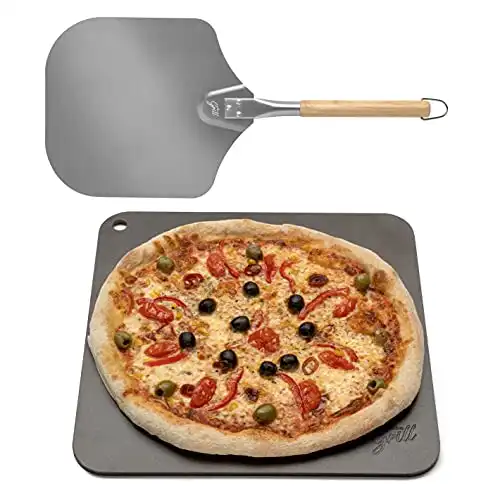
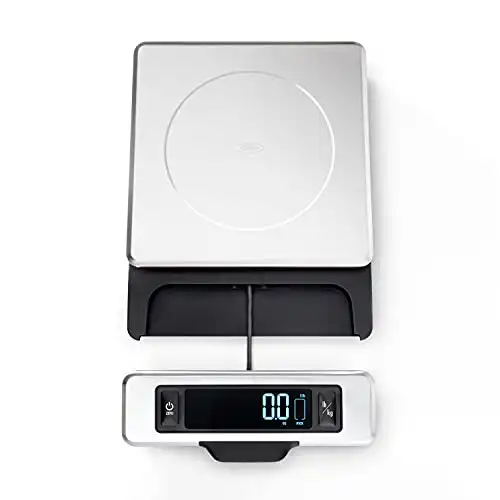
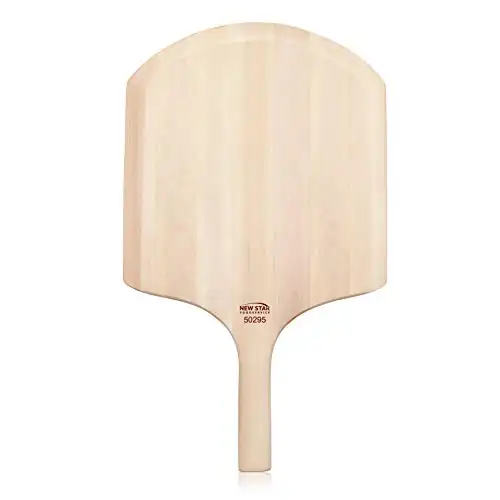
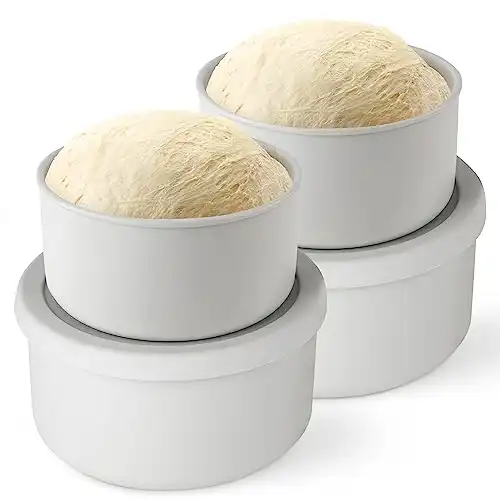
Hello Marie, this by far is the best pizza dough I have ever made! That said, i am on a health kick and would like to try making pizza using whole wheat flour. Have you come across a recipe as good as this using whole wheat?
THanks in advance.
M.
Hi! I’ve had the same thing on my mind! I think you can probably substitute half of the flour using a white whole wheat, but I havne’t done it myself yet and not sure how widely available white whole wheat is around the US. Most wheat flour is the red wheat which is much more bitter. If I come across something, I’ll do a post…sorry I can’t be more help here.
This is great! i halved the dough, cooked 1 after 24 hrs and 1 after 72 and the 72 hr one was much better. I do add some wheat glouton because i do like my pizza dough to be a little chewier. on the sauce thought, instead of tomato puree, i used peeled diced tomatoes and put the stick blender to it for just a couple pulses. I found the tomato puree to make too rich of a flavor, where the diced tomato sauce was much lighter, plus the final product looked like i rememberd it out east! this is exciting.
Great to hear! I’ve moved away from puree also..it’s one thing about cooking, you are constantly tweaking things. I probably should update that!
Marie, great recipe. Love it! I love it so much I would love to make some pizzas during the week after work. So my question is, since by the time I get home from work I do not have time to take the dough out of the fridge and wait 2 hours for it to come to room temp. Would it be ok to take the dough out of the fridge in the moring before I leave work and let it sit at room temp for 9 hours? I have those cool bags that keep food hot or cold for 3 hours. I could always put the dough in the bag which would of course lessen the time it would be at room temp.
Hi Mitch – you could take your dough out as soon of fridge as you start preheating your oven when you get home (2 hours is much too long), and it will be fine. Honestly, I’ve used dough that isn’t at room temp as it’s fine. I would not let it sit out for 9 hours though..hope this helps!
Thanks Marie, that’s good to know.
Hi Marie,
I have just started experimenting with home made pizzas. I have come up with a great sauce but am having trouble getting a good crust, after many attempts. I have not tried this recipe yet but will try this weekend. I am using a stone in my bbq to bake. Just a couple of questions, what does “careful not to degas” mean? Also, in the video above, the dough seems very dry and easy to stretch. My biggest problem is having the dough spring back without stretching. Any suggestions on how to get the dough to stretch easily? Thanks.
Hi Brian – I don’t have trouble with the dough springing back using this recipe, although I have experienced what you are describing with other recipes. I think the long rest period really helps with that. Also, NY style pizza dough is not a “wet” dough and so that’s what you are seeing on that video. Careful not to degas just means try not to press down on the whole dough ball (ie, don’t press the air out of the rim or what will eventually be the crust). And don’t use a rolling pin, and you will be fine – good luck, I hope you like it!
This recipe is amazing, I just made the best pizza of my life. I used your dough and made a cheesy crust pizza and it was just fantastic, the texture of the dough is perfect. I also did one yesterday and the dough definitely wasn’t as flavourful, the extra 24 hours really made a big difference.
I made an album of photos if you’d like to see: http://imgur.com/a/JILHF
Hi Steve – your pizza looks so good! Thanks for sharing the photos. Yes, the overnight fermentation makes a huuuge difference in flavor. Once you get used to it, you definitely get spoiled:)
Hello! I just attempted this dough. For some reason the dough was Very sticky. I followed the measurements exactly. Any reason in particular the dough would be almost runny?
Hi Caitlin – Hmmmm…I really couldn’t say. It definitely should not be runny. It’s a 62% hydration dough, which is not a wet dough (ie, not a runny dough). I wish I could be of more help but it’s hard to say without being there with you. I hope that you can try again if you are feeling up to it..
I’m sorry if this has been asked already, but there are a lot of comments to go through! Can you make this dough in a breadmaker? Thank you! 🙂
Hi Richelle – I don’t believe anyone has asked that question…unfortunately, I’m not familiar with using a bread maker. I’ve read mixed reviews, so the best advice that I can give is to try it out and compare to using a standing mixer (if you have one) and even hand kneading. It certainly can’t hurt to try. You can also use a food processor but the dough should only be mixed for 45 seconds or the gluten will be damaged/shredded. Good luck and have fun experimenting!
Thank you! I’ll try it all three ways and let you know how it works! 🙂
Can this dough be used for calzone / Stromboli? Thanks!
absolutely!
I just wanted to thank you for your blog and recipe. My husband and I both grew up in NJ where there are Mom & Pop pizza shops everywhere, so we are used to a New York style pie. He joined the military in 1986 and we have lived many years in the Carolinas and most recently Virginia. We quickly learned that, the further south that you go, the less pizza tastes like what we were use to. This prompted me to set out on trying to make my own pizza at home. We recently bought a Pizza Kettle Oven insert for our grill and just used it with your recipe for the dough. The only change that I made to your recipe was that I used a fine 00 grade pizza flour. I’m happy to say that the result was almost dead on to the pizza that we grew up with! I can’t thank you enough for both the recipe, and the video on how to form the dough.
That’s great Bonnie! I’ve been dying to try the Pizza Kettle Oven insert…I’m glad to hear that you like it. It’s definitely on my wish list! I am currently using the Pizza Steel for my indoor oven because my pizza stones kept breaking.
Unbelievable. Love it. Work out perfect. U do perfer the crusty base more as I have tried both all purpose and 00 flour. With your sauce I just added some red wine with some paste , it really work a treat. Thank for your help:)
Chris from down under
Hi Chris – never tried this with the 00 flour, but I do prefer the AP flour to the bread flour, although the latter is what I recommend people begin with as that is supposedly the “real” NY style crust.
Glad you liked it! Red wine sauce sounds heavenly!
Woah! I just made a batch of these yesternight which I then divided into 4 balls. Two I kept in the refrigerator for dinner tonight and I froze the other two balls right away. I see you mentioning here to give it a one day proof before transferring it to the freezer! Do you think those two balls of dough I froze right away are goners??? 🙁
I would die if that happens Lol
What I had in my mind was that I would put those dough balls in the fridge the night before and then the next night I would keep them on the counter for two hours before finally baking them! Would this method fail??
Because I have made this recipe before and the balls which I froze right away didn’t come out well!
Help?
P.S. Your ideas are great and I love how you took time to reply to each and every comment! 🙂
Love you Marie! This is my first comment 🙂
Hi! Thanks for your kind words:) I don’t think I’ve ever put my dough straight into the freezer. I usually freeze when I realize that I can’t use all 4, so it would normally be after 2 or 3 days in the fridge. Your method sounds reasonable to take out the night before and then do a counter rise. I’ve never done it that way, so I’d be interested in hearing how it works out for you! Good luck!
I read the careful not to degas part when taking it out of the fridge from the rise. I’m a total newb…How do I stretch or pat it out without doing so? Or direct me to where you posted it if my infant/toddler haze caused me to totally miss it. Thanks- Can’t wait to try! Love your blog!
Hi Pamela – there is a video just before the recipe (right after tip 14). It’s a youtube video that shows a man in a pizzeria. The most important thing is not to use a rolling pin for this style of pizza.
Best pizza dough post ever! I tried it today and it was amazing. I have been trying to make good pizza dough for at lest 10 years and this finally did it for me! THANKS!
Hi Roark – I’m glad it worked out for you!
i want to make a couple dough. so if want to make pizza anytime i want. can i preserve the dough in the freezer for more than 3 days or a week? and what the first thing to do when i finish kneading the dough. let it cool in the ref for 1 night and then put this in the freezer for 2 days. or put directly in the freezer for 3 days or more? im beginner for making pizza dough i want to try this recipe sooner.. tnx..
Hi Jun – I’ve frozen the dough for up to a week before and it has been fine. I haven’t really tried it for longer than that but you can probably freeze it for up to 1 month. After kneading it, shape it into a round flat and place it into a freezer bag. I usually take the dough out the morning that I’m going to use it and just put it into the refrigerator to thaw. I take it out of the fridge when I begin to preheat my oven (usually takes about 45 to 60 minutes)
Wow! I made this today and it was incredible. I have tried many many times to make a decent pizza crust and failed. This was definitely as good as I have had in NYC. I made ia mistake and used Active Dry Yeast instead of instant but it turned out terrific! But I had trouble with stretching the dough on the peel. I could not find the instruction video you mentioned anywhere.
Thanks for the recipe!!
Hi Terence – thank you! I’m glad you liked it. The video is back up if you’d like to check it out…